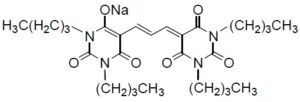DiBAC4(3)

Reagent for Monitoring Membrane Potential
-
Product codeD545 DiBAC4(3)
-
CAS No.70363-83-6(free acid)
-
Chemical nameBis(1,3-dibutylbarbituric acid)trimethine oxonol, sodium salt
-
MWC27H39N4NaO6=538.61
| Unit size | -- | |
|---|---|---|
| 25 mg | Please inquire distributors about price. | |
Product Description
DiBAC4(3) is a Bis-oxonol-type, membrane-potential, sensitive dye. According to membrane depolarization detection, when DiBAC distribution in cytosol is increased, the fluorescence intensitiy is increased. Since an argon laser (488 nm) can be used for DiBAC4(3) excitation, it is applicable for flow cytometry and confocal microscopy.
Chemical Structure

References
1) D. E. Epps, M. L. Wolfe and V. Groppi, "Characterization of the Steady-state and Dynamic Fluorescence Properties of the Potential-sensitive Dye Bis-(1,3-dibutylbarbituric acid)trimethine oxonol(Dibac4(3)) in Model Systems and Cells", Chem. Phys. Lipids, 1994, 69, 137.
2) T. Braner, D. F. Hulser and R. J. Strasser, "Comparative Measurements of Membrane Potentials with Microelectrodes and Voltage-sensitibe Dyes", Biochim. Biophys. Acta, 1984, 771, 208.
3) T. T. Rohn, A. Sauvadet, C. Pavoine and F. Pecker, "Xanthine Affects [Ca2+]i and Contractile Responses of Ventricular Cardiocytes to Electrical Stimulation", Am. J. Physiol., 1997, 273, C909.
4) D. J. Mason, R. Allman, J. M. Stark and D. Lloyd, "Rapid Estimation of Bacterial Antibiotic Susceptibility with Flow Cytometry", J. Microsc., 1994, 176, 8.
5) U. Langheinrich and J. Daut, "Hyperpolarization of Isolated Capillaries from Guinea-pig Heart Induced by K+ Channel Openers and Glucose Deprivation", J. Physiol., 1997, 502, 397.
6) V. Dall'Asta, R. Getti, G. Orlandini, P. A. Rossi, B. M. Rotoli, R. Sala, O. Bussolati and G. C. Gazzola, "Membrane Potential Changes Visualized in Complete Growth Media through Confocal Laser Scanning Microscopy of bis-Oxonol-loaded Cells", Exp. Cell Res., 1997, 231, 260.
7) K. S. Schroeder and B. D. Neagle, "FLIPR: A New Instrument for Accurate, High Throughput Optical Screening", J. Biomol. Screening, 1996, 1, 75.
Handling and storage condition
| Appearance: | Reddish orange to red powder |
|---|---|
| Purity (HPLC): | ≧ 98.0 % |
| Solubility in Dimethyl sulfoxide: | To pass test (clear, orange) |
| Molar absorptivity: | ≧ 140,000 (around 493 nm) |
| IR spectrum: | Authentic |
| 0-5°C |












